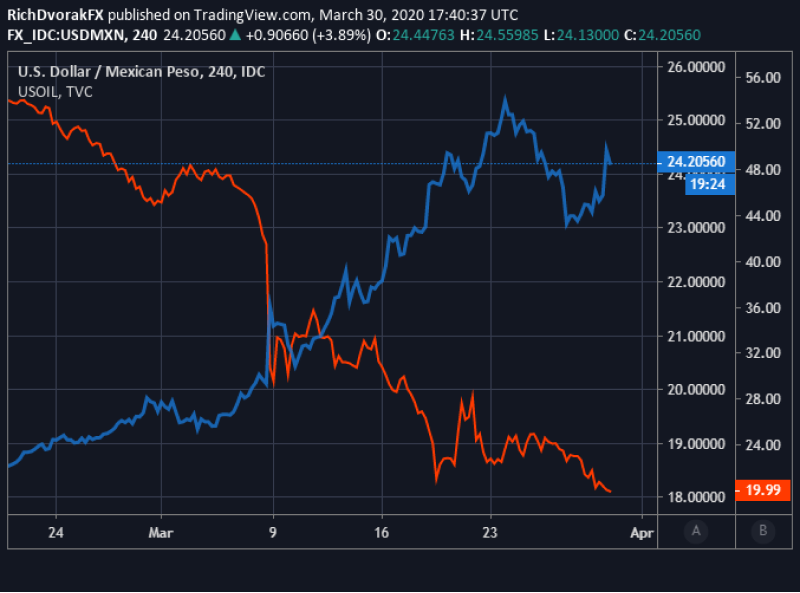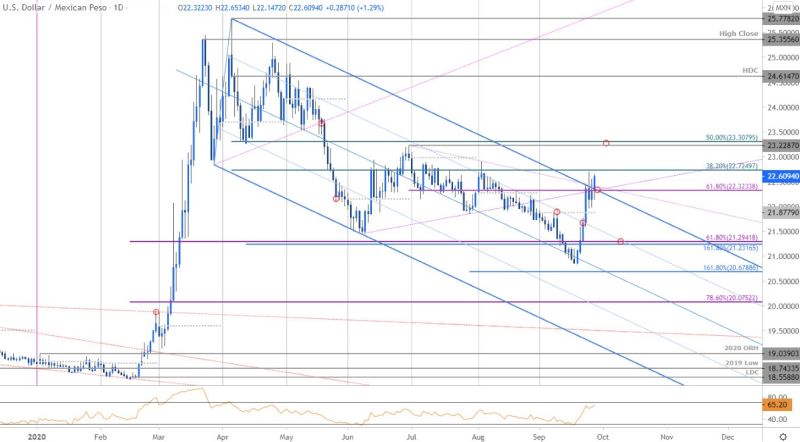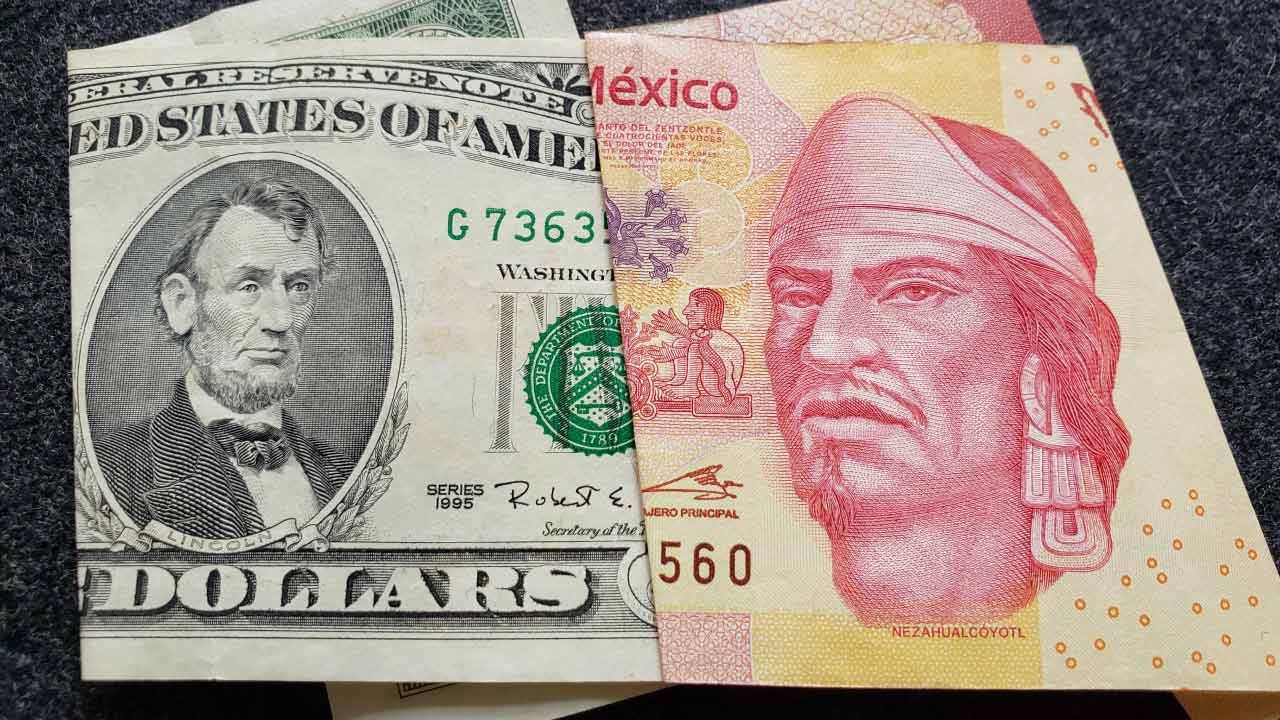Trading the exotic pair, USD/MXN, is influenced by trade agreements, commodity prices, and geopolitical events, providing diversity and volatility. Traders can capitalize on fluctuations, leveraging factors like interest rate differentials and emerging market dynamics for potential gains.
However, it's crucial to acknowledge the inherent risks associated with trading this pair. The volatility of emerging markets, the impact of sudden geopolitical developments, and the possibility of unexpected economic events can all significantly affect the value of the USD/MXN currency pair
However, trading such pairs comes with inherent risks. The volatility of emerging markets, susceptibility to sudden geopolitical developments (such as economic sanctions, diplomatic tensions, international crisis, and more), and exposure to unexpected economic events (such as hyperinflation or recession) can all significantly affect the value of the USD/MXN currency pair. As such, traders must approach trading cautiously and implement robust risk management strategies to mitigate potential losses.
What is the USD/MXN pair?
The USD/MXN pair represents the exchange rate between the United States Dollar (USD) and the Mexican Peso (MXN). It indicates how much one US dollar can be exchanged for Mexican Pesos. In the case of USD/MXN, the United States Dollar (USD) is the base currency, and the Mexican Peso (MXN) is the quote currency. Forex traders use exotic currency pairs like USD/MXN to speculate on or hedge against the fluctuations in exchange rates between different currencies. Various factors, including economic indicators, interest rates, geopolitical events, and market sentiment, can influence the value of the USD/MXN pair.
History of USD/MXN
From 2018 to 2022, the USD/MXN pair has been influenced by various factors. Positive developments in trade relations, such as the signing of the USMCA, generally contributed to a strengthened Mexican Peso against the US Dollar (appreciation of USD/MXN). Trade tensions or uncertainties in trade policies had the opposite effect, leading to increased volatility and potentially a weaker Mexican Peso (depreciation of USD/MXN).
Interest rate differentials, economic data releases, and global events such as the COVID-19 pandemic played roles in determining the pair's direction, initially in the downward and upward directions. Political stability in either country bolstered investor confidence, while elections or political uncertainties introduced volatility. Mexico's dependence on oil exports and changes in commodity prices also influenced the USD/MXN pair. The exchange rate dynamics reflected the complex interplay of economic, political, and global factors during this period. For precise details, real-time data sources and financial analyses for the specific timeframe are recommended.
Why trade the USD/MXN pair?
Trade and economic ties between the US and Mexico
The close economic ties and extensive trade between the United States and Mexico make the USD/MXN pair particularly relevant for traders. As neighboring countries with significant cross-border trade, economic events, policy changes, and trade agreements can profoundly impact the exchange rate. Traders often monitor developments such as trade negotiations, tariff decisions, and changes in economic policies to make informed decisions when trading the USD/MXN pair.
Economic strength of the United States
The economic strength of the United States is a crucial factor influencing the USD/MXN pair. A strong US economy can attract foreign investment and capital flows, leading to a stronger US Dollar relative to the Mexican Peso. Traders assess various economic indicators, such as GDP growth, employment data, and interest rates in the US, to gauge the economy's overall health and anticipate potential movements in the USD/MXN exchange rate.
Relation between Mexican Peso and commodity prices
Mexico's economy is significantly influenced by commodity prices, particularly oil, a major export. The value of the Mexican Peso can be sensitive to changes in global commodity prices. When global commodity prices, particularly oil, rise, it often leads to an appreciation of the Mexican Peso and vice versa due to the direct reliance of Mexico's export revenue on the same. Traders in the USD/MXN pair pay attention to fluctuations in oil prices and other relevant commodities as these can impact Mexico's export revenue, trade balance, and, consequently, the strength of the Mexican Peso against the US Dollar.
Liquidity and accessibility in USD/MXN trading
The USD/MXN pair takes advantage of high liquidity and accessibility in the forex market. The US Dollar is one of the world's primary reserve currencies, and the Mexican Peso is considered an emerging market currency. This combination makes the pair actively traded, providing market participants with ample opportunities for trading. High liquidity ensures that traders can execute orders efficiently without significant price slippage.
Volatility in the USD/MXN pair
The USD/MXN pair exhibits a degree of volatility, creating opportunities for traders to gain from price movements. Various factors contribute to this volatility, including economic releases, geopolitical events, and changes in trade policies. Traders who are comfortable managing risk and seeking potentially higher returns may be attracted to the USD/MXN pair due to its dynamic price action.
Advantages and risks of trading the USD/MXN pair
Advantages
- Correlation with the US dollar index (DXY): The USD/MXN pair often exhibits a strong correlation with the US Dollar Index (DXY), which measures the value of the US Dollar against a basket of major currencies. Traders can use this correlation to gain insights into broader US Dollar trends and make informed trading decisions in USD/MXN.
- Mexican Peso as an emerging market currency: The Mexican Peso is considered an emerging market currency, offering traders exposure to the dynamics of a developing economy. Emerging market currencies can experience higher volatility, providing opportunities for traders to capitalize on price movements.
- Influence of NAFTA/USMCA agreements: The USD/MXN pair is significantly influenced by trade agreements such as the North American Free Trade Agreement (NAFTA) and its successor, the United States-Mexico-Canada Agreement (USMCA). Changes in trade dynamics between these countries can lead to significant movements in the exchange rate, providing trading opportunities.
Risks
- Currency peg possibility: There is a risk that the Mexican Peso could face pressures related to potential changes in exchange rate policies or adopting a currency peg. If implemented, currency pegs can introduce uncertainty and impact the normal functioning of the exchange rate.
- Impact of migration and remittances: Migration trends, particularly between the US and Mexico, can influence the USD/MXN pair. Remittances from Mexican workers in the US contribute significantly to Mexico's economy. Changes in migration policies or economic conditions affecting remittance flows can impact the exchange rate.
- Natural disasters and environmental factors: Mexico is susceptible to natural disasters such as hurricanes, earthquakes, and other environmental factors. These events can disrupt economic activities, impact trade, and create uncertainties that may influence the USD/MXN pair. Traders need to be mindful of these factors when assessing risks.
Top trading strategies to trade the USD/MXN pair
Carry trade strategy
The carry trade strategy involves taking advantage of interest rate differentials between two currencies. While trading USD/MXN, traders would consider the interest rates the US Federal Reserve and the Bank of Mexico set. If the interest rates in the US are higher than those in Mexico, traders may go long on USD/MXN to gain from the interest rate spread.
This strategy assumes that higher interest rates in the US attract capital inflows, leading to an appreciation of the US Dollar against the Mexican Peso. To execute, a trader might enter a long position in the USD/MXN pair. Traders employing this strategy should monitor changes in interest rates, economic data, and central bank statements. It is important to note that carry trades carry the risk of currency fluctuations, and unexpected economic events or policy shifts can impact the effectiveness of the strategy.

Oil price correlation strategy
Given Mexico's significant reliance on oil exports, the USD/MXN pair often correlates with global oil prices. Traders can use this correlation as the basis for their strategy. For instance, rising oil prices could increase Mexico's export revenue and potentially strengthen the Mexican peso, signaling traders to go short on USD/MXN. Conversely, falling oil prices may weaken the Peso. Traders might go long on USD/MXN based on their analysis of oil price trends.
Traders could use technical analysis indicators such as trend analysis tools to analyze historical price charts to identify trends in the USD/MXN pair. Moving averages, trendlines, and chart patterns could be used to understand the currency pair's direction. Identifying key support and resistance levels can help traders determine potential entry and exit points.
Oil market indicators such as OPEC decisions must be monitored to gauge potential movements. If oil prices decline, indicating potential economic challenges for Mexico, traders might consider going long on USD/MXN. Keeping an eye on oil-related news and events is crucial for timely decision-making.
Monitoring oil price movements, understanding the factors influencing oil markets, and staying informed about Mexico's economic dependence on oil are crucial for implementing this strategy. Traders should also know that correlations can change over time, and risk management is essential.

Geopolitical event-based strategy
The geopolitical event-based strategy involves trading the USD/MXN pair based on geopolitical events or news that could impact the currency pair. Geopolitical events, such as trade negotiations, political developments, or major policy announcements, can lead to significant movements in the exchange rate. Positive news may affect the pair positively and vice versa. Traders analyze the potential impact of these events on market sentiment and make trading decisions accordingly, either going long or short on USD/MXN.
Traders often rely on a combination of indicators and tools to assess the potential impact of geopolitical events. Economic indicators from the US and Mexico can provide insights into the overall economic health of the two nations. GDP growth, employment figures, and manufacturing indices can influence market sentiment and the exchange rate. Additionally, economic calendars, which outline the release dates of important economic indicators, are essential tools for traders. These calendars often categorize indicators by their potential market impact (low, medium, or high).
Traders must stay informed about geopolitical developments, economic indicators, and political events in the US and Mexico. The strategy requires quick decision-making and adaptability, as geopolitical events can lead to sudden and substantial price movements. Risk management is crucial to mitigating potential losses during periods of heightened uncertainty.

Breakout trading strategy
The breakout trading strategy involves identifying key support and resistance levels on a price chart and entering a trade when the price breaks out of these levels. While trading USD/MXN, this strategy can be useful when the currency pair consolidates within a range. Breakouts from these ranges can indicate the potential for a new trend, allowing traders to enter positions in the direction of the breakout.
Traders can analyze historical price data to identify relevant support and resistance levels. When the price breaks above resistance or below support, a trader might execute a long or short order, respectively. Stop-loss orders are typically set to manage risk and capture potential gains.
If the USD/MXN pair has been trading within a range, a breakout above a resistance level could signal a potential upward trend. Traders might initiate a long position when the price breaks out, anticipating further appreciation of the USD against the Mexican Peso.

Seasonal trading strategy
Seasonal trading involves analyzing historical patterns or tendencies in the market that occur during specific times of the year. Traders identify recurring trends or behaviors based on historical data and use this information to inform their trading decisions during certain periods. Seasonal patterns can provide insights into historical trends or behaviors of the USD/MXN pair during specific months. Understanding these tendencies can help traders anticipate potential movements and adjust their strategies accordingly.
Traders would study historical price movements and factors influencing the USD/MXN pair during different seasons. If there is a consistent pattern of increased volatility or specific trends during certain months, traders might adjust their trading approach.
For instance, if there is historical evidence of heightened volatility or a recurring trend during a specific season, traders might use this information to time their entries or exits. If historical data suggests a consistent trend of USD/MXN appreciation during a particular season, traders may enter long positions at the beginning and vice versa. This strategy allows traders to align their positions with historical patterns, potentially improving the probability of successful trades.

Navigating through the volatility of USD/MXN
Trading USD/MXN in Forex combines economic intricacies, geopolitical events, and trade relations, offering potential high returns. Traders navigate the pair's volatility by leveraging factors like interest rates, emerging market dynamics, and historical patterns, applying careful analysis and risk management for strategic and informed decision-making.
The examples provided in this article are for illustrative purposes only and should not be considered as personal advice from Blueberry.
All material published on our website is intended for informational purposes only and should not be considered personal advice or recommendation. As margin FX/CFDs are highly leveraged products, your gains and losses are magnified, and you could lose substantially more than your initial deposit. Investing in margin FX/CFDs does not give you any entitlements or rights to the underlying assets (e.g. the right to receive dividend payments). CFDs carry a high risk of investment loss.
Disclaimer: All material published on our website is intended for informational purposes only and should not be considered personal advice or recommendation. As margin FX/CFDs are highly leveraged products, your gains and losses are magnified, and you could lose substantially more than your initial deposit. Investing in margin FX/CFDs does not give you any entitlements or rights to the underlying assets (e.g. the right to receive dividend payments). CFDs carry a high risk of investment loss.




